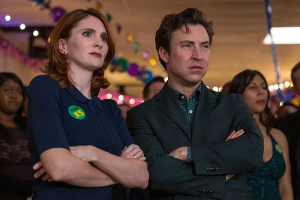
This Halo article contains spoilers.
While it’s never pretended to be a direct adaptation of the classic video game series it’s based on, the Halo TV series has made some really weird alterations to Master Chief and his world, and the latest change to the story Halo fans know and love is the most bewildering yet. It comes just as the show finally sets course to cover the Fall of Reach, a pivotal event from the games and tie-in books that has somehow taken a season and a half to get to.
To be fair, there are a few things to like about season 2 episode 4, “Reach.” For one, at the height of its war-movie-style CGI-heavy action, the show finally feels like Halo and not a talky political thriller that only occasionally flirts with the spectacle of the games. That we’re finally at the Fall of Reach also means the show is one step closer to actually stepping foot on a Halo ring. After all, in the timeline of the games, the destruction of the planet is what causes Master Chief and Cortana to blast off into space on the Pillar of Autumn, a journey that leads them to the Halo installation. The Pillar of Autumn accidentally finding the mysterious ring while trying to escape from Covenant ships is the very first scene of the first game!
But as happy as I am to see the show get to the point after so much setup and odd side quests, it does so while also killing off Admiral Keyes (Danny Sapani), who sacrifices himself so the other characters can escape Reach. It’s a moment that not only doesn’t feel earned, considering how little material Sapani’s Keyes got in the first place, but robs the character of his much better video game ending. Worst of all, the show seems to kill him off simply for the shock value of it, and perhaps to be different from the games, rather than to improve on anything we’ve seen before. When compared to Keyes’ very memorable ending in Halo: Combat Evolved, the show’s version feels bland and uninspired.
In the original Halo game, Captain Keyes bravely leads what forces he has left after the Autumn crash lands on the ring, fighting the Covenant alongside his Marines and Master Chief. Later, he’s also the one who (accidentally) discovers the Flood, the parasitic alien lifeforms the Halo rings were actually built to contain. While Keyes is infected by the parasite, turning him into a grotesque mass of flesh, he refuses to give into the Flood’s mental manipulation and reveal information that would allow them to get off the ring. Keyes withstanding this torture buys Master Chief and Cortana enough time to stop the Flood by blowing up the Autumn’s reactors and destroying the ring. It’s also the neural implant inside Keyes’ head that allows the heroes to destroy the ring in the first place.
In other words, Keyes’ role in the game version of what’s presumably to come on the show is an important one. One could be an optimist and assume that the TV series has decided to excise Keyes from these events because it’s landed on a fresh, unexpected, and perhaps more exciting way to tell this particular story. But that’s not really been true of any of its deviations so far…
The Halo TV series exists on the Silver Timeline, an alternate universe where the team at Paramount is free to tell the story of Halo in any way it sees fit without clashing with the games people love. So far, that’s meant deep dives into the UNSC’s war crimes and the dark origins of ONI’s Spartan program, an admirable attempt to expand the lore of the games and bring in material from the books but that unfortunately slowed the show down to a crawl in its first season. It’s also meant getting to know Insurrectionists like Soren (Bokeen Woodbine) and Kwan (Yerin Ha), the people Spartans were originally created to oppress, but those characters have at the best of times felt like diversions before getting back to the Master Chief scenes — which honestly aren’t great, either.
No, I’m not mad that John-117 walks around without a helmet or that sometimes he strips his armor off to fuck. Fair enough, let good-looking Pablo Schreiber act, guys. But the show’s Master Chief has largely felt like he’s on an eternal timeout, barely seen with an assault rifle in his hand or elbowing Grunts in the face. While the games strike the right balance between hinting at the sad, broody guy behind the helmet and the killing machine who eats Elites for breakfast, the show has zoomed way in on the former, giving us a Spartan who’s more prone to mope around an ONI facility and ask to see the manager than stop the Covenant from wiping out all sentient life in the galaxy.
It all begs the question: who exactly was this show created for? The series has so often ignored what makes the games so beloved for what seems like arbitrary reasons that it’s hard to believe they’ve made it for Halo fans at all.
Then again, perhaps the Fall of Reach, and the death of Admiral Keyes, is meant to be the wake up call Chief (and the show) needs to finally kick things into gear and finish the fight. It’s just too bad one of the original game’s most important character won’t be around to see it through.
New episodes of Halo release on Thursdays on Paramount+.
The post Halo Season 2 Episode 4’s Big Death Confirms This Show Doesn’t Like the Games appeared first on Den of Geek.










